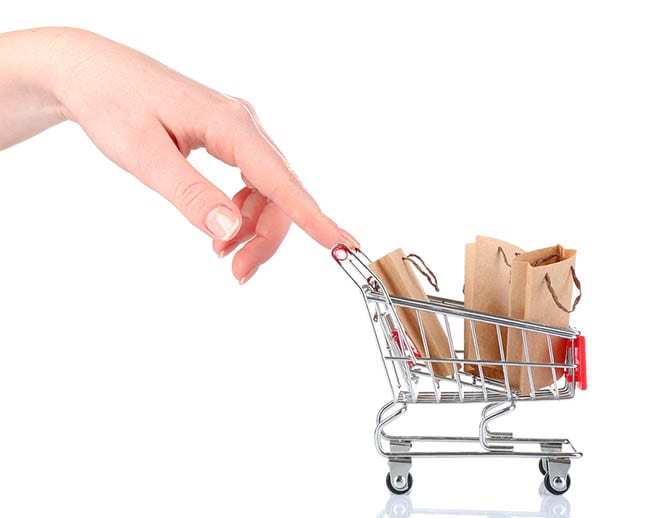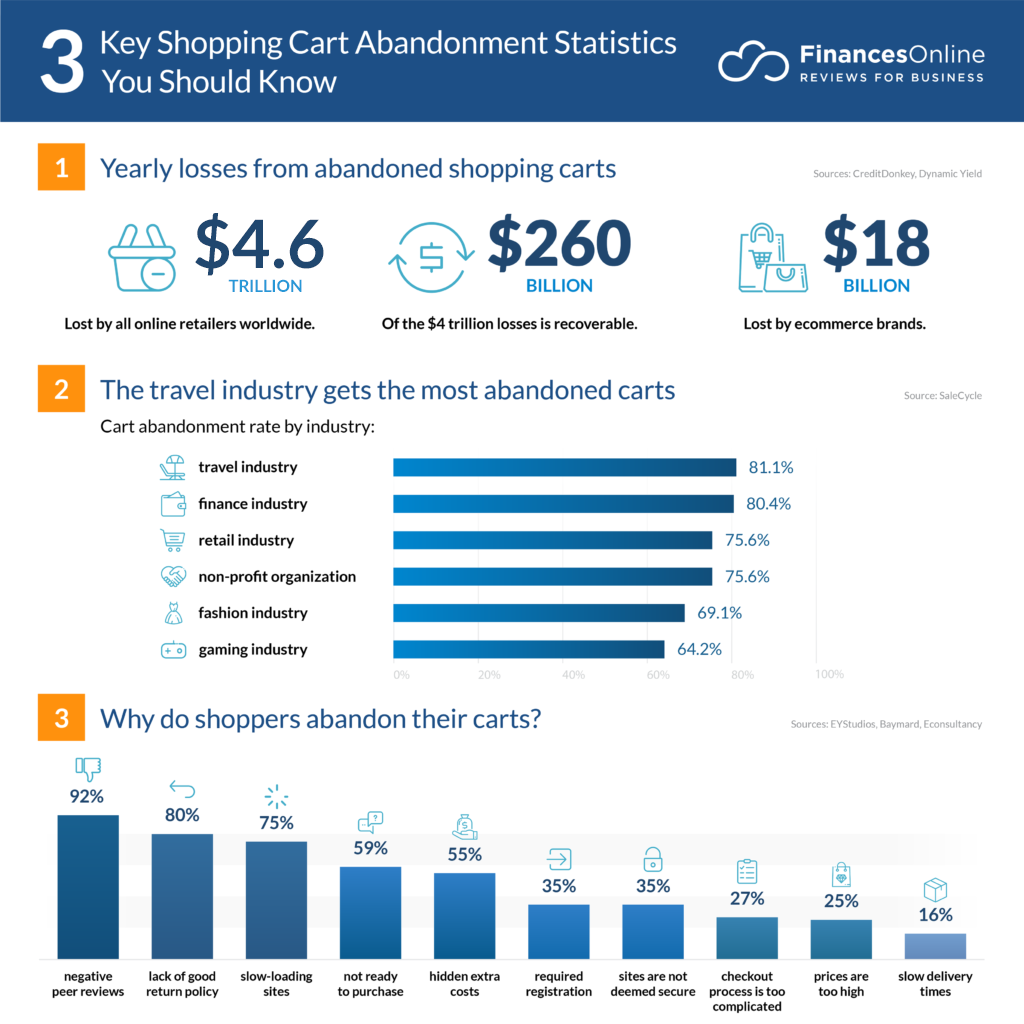50 Statistics On Cart Abandonment & How You Can Defeat It

Digital marketing places a great deal of importance on attracting and retaining customers. However, increased engagement on your website doesn’t ensure increased revenue.
Visitors might add items to the cart but leave without making any purchase. And that puts retailers in the difficult place of overcoming cart abandonment issues to ensure the continuity of their e-commerce businesses.
In fact, think tanks estimate that shoppers leave more than $4 trillion in unbought goods in their shopping carts every year, abandoning the sale for one reason or another. Let’s dive in together to determine the root causes of cart abandonment and steps you can take to defeat it once and for all.
What Causes Cart Abandonment?
A high abandonment rate can be caused by a poor user experience or a disrupted sales funnel. The most common causes include: lack of competitive pricing or pricing transparency, high shipping costs, bad return policy and lack of customer support.

With this in mind, retailers should take extra precautions to find its root causes and fix them, prioritizing the streamlining of the checkout process and keeping customers happy throughout the funnel. Of course, all that is easier said than done, as evident by industry statistics.
Next, we’ll explore this in greater detail, so you can learn what the primary causes are as well as some tactics that you can use to reduce cart abandonment at your online store.
Statistics On Cart Abandonment
You’ve worked hard to get visitors and bring them to the end of the sales funnel; you even created special offers to keep them interested. But all that diligence goes in vain because they abandon ship later on in the purchasing process.
You aren’t alone. We’ve already dropped a helpful guide on 2021 statistics on shopping cart abandonment, so here’s a brand-new one that’s more in par for 2022 and beyond.
➡️ In 2020 53% of people declared that free shipping is the primary motivator for them worldwide for online purchases. (Statista)
➡️ 48% of customers say they abandon shopping carts because of the unexpectedly high delivery cost. (Baymard Institute)
➡️ Before making a purchase, 86% of online customers discarded an item from their shopping carts. (CSA)
➡️ 61% of respondents said they abandoned their shopping carts due to additional costs such as shipping expenses. (ReadyCloudSuite)
➡️ Emails sent to customers who abandoned their shopping carts had a 45% open rate. (Moosend)
➡️ 75% of online shoppers want free shipping and would abandon their order if the price is too high. (NRF)
➡️ As COVID-19 began in 2020, the abandonment rate for fashion products rose from 84.3% to 96.50%. (Today)
➡️ Creating an online account, a lengthy checkout process, and a slow delivery is the most common inconveniences for most customers while shopping online. (Baymard Institute)
➡️ In March 2021, almost 80% of online orders were abandoned, with automotive at the highest with an 89.11% abandonment rate. (Statista)
➡️ Americans are less inclined to buy something on the internet if the checkout procedure takes more than 30 seconds. (Forter)
➡️ Retargeting is one of the most underutilized forms of online marketing, according to the opinions of 46% of marketing professionals. (ReadyCloudSuite)
➡️ Real-time tailored messages effectively increased average basket value and prevented cart abandonment for a luxury home brand. (Socital)
➡️ Any add-to-cart rate above 8.2% would place you in the top 20% of stores, and any add-to-cart rate above 10.6% would place you in the top 10% of stores. (Littledata)
➡️ Some 9% of customers abandoned their carts because the merchant didn’t have good payment options. (Baymard Institute)
➡️ 10% of customers abandon purchases due to the site’s inadequate return policies. (Chargebacks911)
➡️ The rate of abandonment among mobile users is 85.65%. (Barilliance)
➡️ The average add-to-cart rate is between 2.5 and 6.87 %. (Dynamic Yield)
➡️ With an abandonment rate of 90.88 %, the Middle East tops the list of countries with the most abandoned shopping carts, closely followed by Africa (86.37 %), South America (86.5 %), Asia Pacific (82.49%), North America (83.48%), and Europe (81.49 %). (Statista)
➡️ Cart abandonment for cosmetics fell by 7.6% in 2020. (Today)
➡️ The average order value can rise by 33% due to product recommendations. (Kibo)
➡️ When retargeting is done correctly, customers have a 70% probability of converting. (ReadyCloudSuite)
➡️ Over 60% of shopping carts are abandoned because of delivery issues. (Moosend)
➡️ The estimated value of abandoned online shopping carts in 2021 was $4 trillion. (Swrve)
➡️ For mobile, the abandoning cart rate is 85.65%; for tablets, it is 80.74%; for desktop, it is just 69.5%. (Baymard Institute)
➡️ Abandoned digital cart items were worth $705 billion in the United States. (eMarketer)
➡️ The add-to-cart rate was highest in 7.81% of desktop customers, 7.69% of customers on tablets, and 6.34 % of customers on mobile devices. (Dynamic Yield)
➡️ More than one-third of UK shoppers who abandon a shopping basket do so by purchasing from the same site at a later point in time (31%), by purchasing from another seller (26%), by stopping purchasing (23%) and by going into a physical store to buy (8%). (Royal Mail)
➡️ 15% of customers abandoned their shopping carts because they couldn’t remember their passwords. (CSA)
➡️ 58.6% of cart abandoners were only looking or not prepared to buy when abandoning their carts. (Baymard Institute)
➡️ 22% of customers abandon their shopping carts when the website crashes or has too many faults. (Chargebacks911)
➡️ Black Friday 2021 saw a shopping cart abandonment rate of 76.63%. (SaleCycle)
➡️ The cart abandonment rate shot up to 80.79% for those shopping on mobile. (Barilliance)
How To Defeat Cart Abandonment
The good news is that it’s possible to reduce the cart abandonment rate. Here are a few statistics explaining how other e-commerce businesses managed to do that.
➡️ Most customers (92%) said they would repurchase the same product if returning it was simple. (Invesp)
➡️ Retargeting can lower cart abandonment by 6.5% and boost online sales by nearly 20%. (MOTOCMS)
➡️ 10% of cart abandonment emails resulted in a purchase. (Moosend)
➡️ Additionally, an email with the subject line “you left something behind” has an open rate of 47.67%, almost 4% greater than the average open and click of the email. (Klaviyo)
➡️ Customers are 40 % more likely to purchase if an online retailer offers a variety of payment methods. (StableWP)
➡️ 55% of consumers are more inclined to purchase a product they viewed online if it is easier and quicker. (CSA)
➡️ 3 out of 4 consumers are aware of retargeted online advertisements. (Invesp)
➡️ When consumers see credit card logos on a retailer’s website, 84% of customers feel more secure. (StableWP)
➡️ By far, the most important aspect when making an online purchase is customer feedback and reviews, followed by free shipping (78%), the availability of several brands (65%), and personal recommendations from family members (60%). (PowerReviews)
➡️ The number of carts that might be reclaimed for every one hundred SMS abandonment messages delivered to clients is as high as twenty. (MessageMedia)
➡️ Offering free shipping with automated cart abandonment emails can bring back more than 20% of abandoned carts. (Moosend)
➡️ At the end of November 2021, the aggregate conversion rate was 2.42%, with a $120.98 average order value, resulting in an 11.67% increase over the order value in November 2020 across all industries worldwide. Meanwhile, the average cost of goods sold was $62.74. (IRP)
➡️ 35.26 % more customers can be converted with a more user-friendly checkout experience. (Okendo)
➡️ A 44.37 % open rate and a 10.85% clickthrough rate were recorded for emails sent to customers who had abandoned their shopping carts. (Klaviyo)
➡️ Thursday is the busiest day for fashion goods sales, and 8 PM is the most active hour. (SaleCycle)
➡️ After 30 minutes (almost 15%), 20 minutes (just over 13%), and one day (nearly 16%), sending email results in a conversion rate of approximately 16 % (just above 11%). (Shopify)
➡️ Most retail websites can minimize the number of checkout forms by 20% to 60%. (Baymard Institute)
➡️ 77% of customers prefer to make their purchases through Amazon because of the convenience of the online checkout process. (CSA)
The Big Summation
You’re missing out on a lot of money if your prospective customers aren’t completing the purchase. The good news is that your website is already attracting visitors. But these facts about shopping cart abandonment don’t lie: Customers expect a smooth buying process, low-cost or free shipping, competitive pricing and easy returns, or they will shop somewhere else that offers this.
Next, you need to implement our tried-and-tested shopping cart recovery tactics. For starters, start sending out cart abandonment emails, remarket to customers who leave in the middle of the purchase process, streamline your checkout processes, and don’t forget to be transparent with shipping costs while offering a hassle-free return policy to close the deal.
Shoppers are more likely to leave a website because of complicated checkout processes, ambiguous pricing, and excessive delivery fees. Make sure that these issues don’t plague your website. Invest in an ecommerce suite like ReadyCloud, where you can take advantage of an orders-based CRM, multicarrier shipping software and automated ecommerce returns solution to reduce cart abandonment.
Need Even More Tips?
We’ve got you covered. Check out this illustrated infographic on shopping cart abandonment that we’ve created below. If you still need more tips, we’re here for you. Read our Ultimate Guide to Beating Shopping Cart Abandonment.

Share On:








